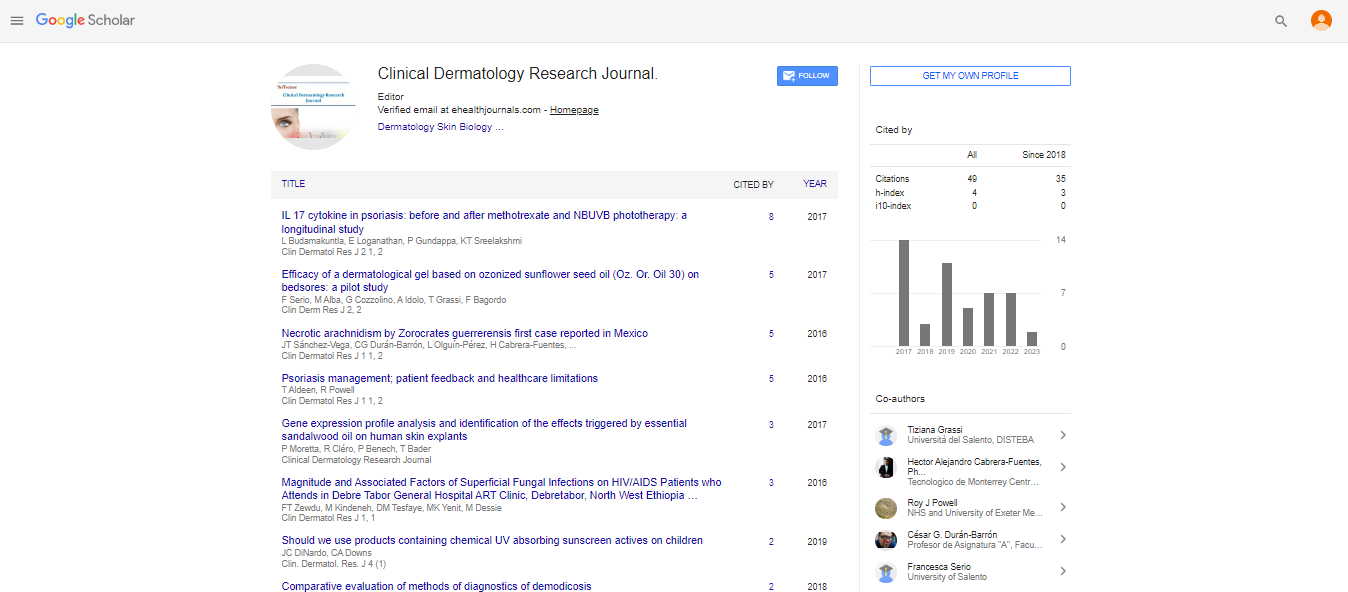Opinion Article, Vol: 8 Issue: 3
Molecular Mechanisms of Skin Cancer Development and Progression
Ahmad Maeve*
1Department of Dermatology, University of California, San Francisco, San Francisco, California, USA
*Corresponding Author: Ahmad Maeve,
Department of Dermatology, University
of California, San Francisco, San Francisco, California, USA
E-mail: Ahmad.maeve@hsc.edu
Received date: 30 August, 2023, Manuscript No. CDRJ-23-115489;
Editor assigned date: 01 September, 2023, PreQC No. CDRJ-23-115489(PQ)
Reviewed date: 15 September, 2023, QC No. CDRJ-23-115489;
Revised date: 22 September, 2023, Manuscript No. CDRJ-23-115489 (R);
Published date: 29 September, 2023, DOI: 10. 4172/2576-1439.1000212
Citation: Maeve A (2023) Molecular Mechanisms of Skin Cancer Development and Progression. Clin Dermatol Res J 8:3.
Description
Skin cancer is one of the most common types of cancer worldwide, with its incidence steadily rising over the past few decades. It primarily occurs due to the uncontrolled growth of skin cells, resulting in the formation of malignant tumors. Understanding the molecular mechanisms behind skin cancer development and progression is crucial for the development of effective prevention strategies and treatments. This essay delves into the intricate molecular processes that underlie the development and progression of skin cancer.
Skin structure and function
Before delving into the molecular mechanisms of skin cancer, it is essential to understand the normal structure and function of the skin. The skin is the largest organ in the human body, serving as a protective barrier against external factors such as UV radiation, pathogens, and chemicals. It consists of three main layers: the epidermis, dermis, and subcutaneous tissue. The epidermis, the outermost layer, contains various cell types, including keratinocytes, melanocytes, and immune cells. Keratinocytes are the predominant cell type and play a crucial role in skin cancer development.
One of the primary risk factors for skin cancer is exposure to UV radiation from the sun. UV radiation can induce DNA damage in skin cells, particularly in keratinocytes. The two main types of UV radiation, UVA and UVB, can cause mutations in critical genes, such as TP53 and BRAF. Mutations in these genes disrupt cell cycle control and promote uncontrolled cell growth, contributing to the initiation of skin cancer. Several molecular pathways are implicated in the development of skin cancer. The Mitogen-Activated Protein Kinase (MAPK) pathway is frequently deregulated in skin cancer, with mutations in the BRAF gene being a common occurrence. These mutations lead to constitutive activation of the MAPK pathway, promoting cell proliferation and survival.
Skin cancer development often involves the inactivation of tumor suppressor genes that normally prevent uncontrolled cell growth. The TP53 gene, which codes for the p53 protein, is a critical tumor suppressor in skin cells. Mutations or inactivation of TP53 can lead to the loss of its regulatory function, allowing cells with damaged DNA to continue dividing. Telomeres are protective caps at the end of chromosomes that shorten with each cell division. Telomere shortening is a natural process that limits the number of times a cell can divide. In skin cancer, mechanisms that maintain telomere length, such as activation of telomerase, can enable cells to bypass this limitation and continue dividing uncontrollably.
Skin cancer progression involves a series of events that transform localized tumors into invasive and metastatic cancers. These molecular mechanisms are vital for understanding how skin cancer becomes more aggressive. As skin cancer tumors grow, they require a blood supply to provide nutrients and oxygen. Angiogenesis, the formation of new blood vessels, is a critical step in cancer progression. Tumor cells release angiogenic factors, such as Vascular Endothelial Growth Factor (VEGF), to stimulate the growth of blood vessels into the tumor.
The invasion of cancer cells into surrounding tissues and their subsequent spread to distant organs (metastasis) are hallmark events in cancer progression. Various molecular changes, including alterations in cell adhesion molecules and increased motility, enable cancer cells to invade neighboring tissues and enter the bloodstream or lymphatic system.
The immune system plays a crucial role in recognizing and eliminating cancer cells. However, skin cancer cells can develop mechanisms to evade immune surveillance. Immune checkpoint molecules like PD-1 and PD-L1 are often upregulated in skin cancer, inhibiting immune cell activity and allowing cancer cells to escape immune attack.
Skin cancer is a complex disease with multiple molecular mechanisms driving its development and progression. UV radiationinduced DNA damage, dysregulated signaling pathways, inactivation of tumor suppressor genes, and telomere maintenance all contribute to the initiation of skin cancer. As the disease progresses, angiogenesis, invasion, metastasis, and immune evasion become central to its aggressive behavior.
Understanding these molecular mechanisms is essential for the development of targeted therapies and prevention strategies. Advances in molecular biology and genetics have provided valuable insights into the underlying biology of skin cancer, leading to the development of novel treatments, including targeted therapies and immunotherapies. Ultimately, continued research into the molecular mechanisms of skin cancer will contribute to better outcomes for patients and a reduction in the global burden of this prevalent malignancy.
 Spanish
Spanish  Chinese
Chinese  Russian
Russian  German
German  French
French  Japanese
Japanese  Portuguese
Portuguese  Hindi
Hindi 

